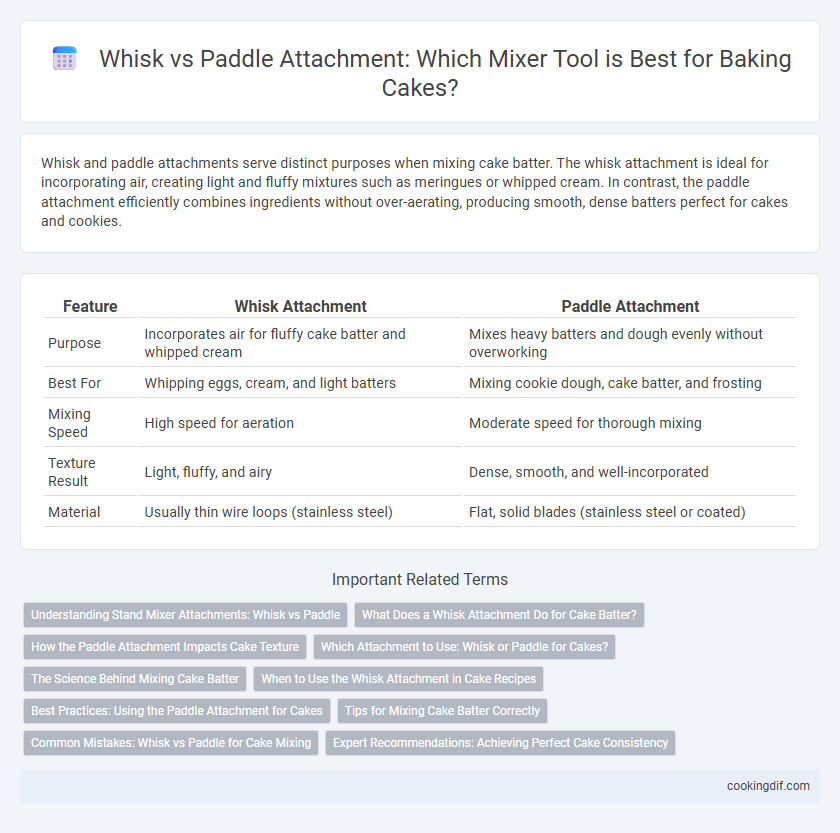Whisk and paddle attachments serve distinct purposes when mixing cake batter. The whisk attachment is ideal for incorporating air, creating light and fluffy mixtures such as meringues or whipped cream. In contrast, the paddle attachment efficiently combines ingredients without over-aerating, producing smooth, dense batters perfect for cakes and cookies.
Table of Comparison
| Feature | Whisk Attachment | Paddle Attachment |
|---|---|---|
| Purpose | Incorporates air for fluffy cake batter and whipped cream | Mixes heavy batters and dough evenly without overworking |
| Best For | Whipping eggs, cream, and light batters | Mixing cookie dough, cake batter, and frosting |
| Mixing Speed | High speed for aeration | Moderate speed for thorough mixing |
| Texture Result | Light, fluffy, and airy | Dense, smooth, and well-incorporated |
| Material | Usually thin wire loops (stainless steel) | Flat, solid blades (stainless steel or coated) |
Understanding Stand Mixer Attachments: Whisk vs Paddle
The whisk attachment in stand mixers aerates ingredients, ideal for whipping egg whites, cream, and meringues, creating light and fluffy textures. The paddle attachment efficiently mixes cake batters and cookie dough, combining wet and dry ingredients without over-aerating, ensuring a smooth, consistent crumb. Choosing the correct attachment optimizes mixing efficiency and final cake texture, enhancing baking results.
What Does a Whisk Attachment Do for Cake Batter?
A whisk attachment aerates cake batter by incorporating air, resulting in a light and fluffy texture essential for sponge and chiffon cakes. It rapidly blends ingredients while adding volume, which is crucial for achieving a tender crumb. Unlike a paddle attachment that mixes thoroughly without adding air, the whisk attachment ensures optimal rise and softness in delicate cake recipes.
How the Paddle Attachment Impacts Cake Texture
The paddle attachment aerates cake batter less than the whisk, creating a denser and moister crumb ideal for butter cakes and pound cakes. Its flat blades gently mix ingredients without incorporating too much air, preventing over-fluffy or crumbly textures. Using the paddle attachment ensures even distribution of fats and sugar, resulting in a tender, consistent cake texture.
Which Attachment to Use: Whisk or Paddle for Cakes?
The whisk attachment is ideal for incorporating air into cake batters, producing light and fluffy textures essential for sponge and chiffon cakes. The paddle attachment ensures thorough mixing of denser batters like butter cakes, providing even blending without over-aeration. Selecting the correct attachment enhances cake structure and texture, optimizing baking results.
The Science Behind Mixing Cake Batter
Whisk attachments incorporate numerous thin wires to incorporate air rapidly, enhancing cake batter volume through aeration critical for light, fluffy cakes. Paddle attachments, featuring flat blades, mix ingredients more gently, preventing over-aeration to maintain proper batter density and consistency crucial for tender crumb textures. Understanding the science behind mixing emphasizes selecting the attachment to balance aeration and mixing power, directly impacting the cake's rise, texture, and overall quality.
When to Use the Whisk Attachment in Cake Recipes
Use the whisk attachment in cake recipes when incorporating air into the batter is essential, such as for sponge cakes, chiffon cakes, and angel food cakes where lightness and volume are key. The whisk attachment excels at whipping egg whites or cream to stiff peaks, creating a delicate, airy texture. Avoid using the whisk for dense or heavy batters, where the paddle attachment provides better mixing without over-aerating.
Best Practices: Using the Paddle Attachment for Cakes
The paddle attachment is ideal for mixing cake batters because it evenly combines ingredients without over-aerating, resulting in a tender crumb and consistent texture. It effectively beats butter and sugar to a fluffy consistency while gently incorporating dry ingredients, which helps maintain the cake's structure. Using the paddle attachment at medium speed ensures thorough mixing without developing gluten, key for moist and delicate cakes.
Tips for Mixing Cake Batter Correctly
Using a whisk attachment aerates cake batter, creating a lighter texture ideal for sponge or chiffon cakes, while the paddle attachment gently combines ingredients for denser batters like butter cakes. Whisking incorporates air, enhancing volume, but overmixing with the paddle can lead to a tough crumb due to gluten development. To mix cake batter correctly, start slow to avoid splattering, use the paddle for thorough but gentle mixing, and switch to the whisk when lightening consistency is needed without overbeating.
Common Mistakes: Whisk vs Paddle for Cake Mixing
Using a whisk attachment instead of a paddle for cake batter often leads to over-aeration, causing a dry or crumbly texture. Conversely, applying a paddle attachment when a whisk is needed can prevent proper incorporation of air, resulting in a dense cake. Correctly matching the attachment to the recipe ensures optimal texture and volume in cake mixing.
Expert Recommendations: Achieving Perfect Cake Consistency
Experts recommend using a whisk attachment for incorporating air into cake batter, resulting in a light and fluffy texture. The paddle attachment is preferred for denser cakes, efficiently blending ingredients without overmixing and ensuring a tender crumb. Choosing the right attachment based on the cake type helps achieve the perfect consistency and enhances final product quality.
Whisk vs Paddle Attachment for mixing Infographic

 cookingdif.com
cookingdif.com